From sculpted sandbars to trailing tributaries, the water themed god-game Tidal Tribe is no day at the beach
Type: Single-player
Genre: Simulation, God Game
Developer: PowPit
Publisher: PowPit
Release date: 18 July, 2019


When I was a kid, and much to my father’s chagrin, I would dig small trenches in the backyard garden, crafting a maze of canals, and then filling them with a hose to marvel at the tributaries, dams, waterfalls and ponds that I had so carefully carved. The new god-game Tidal Tribe attempts to capture this sensation by letting you dig digital pathways to guide the flow of water through an idyllic landscape, but instead of making a mess of a garden, the goal is to use the movement of water to grow life, and help the tiny villagers of a virtual island thrive amidst the tide-pools you create.
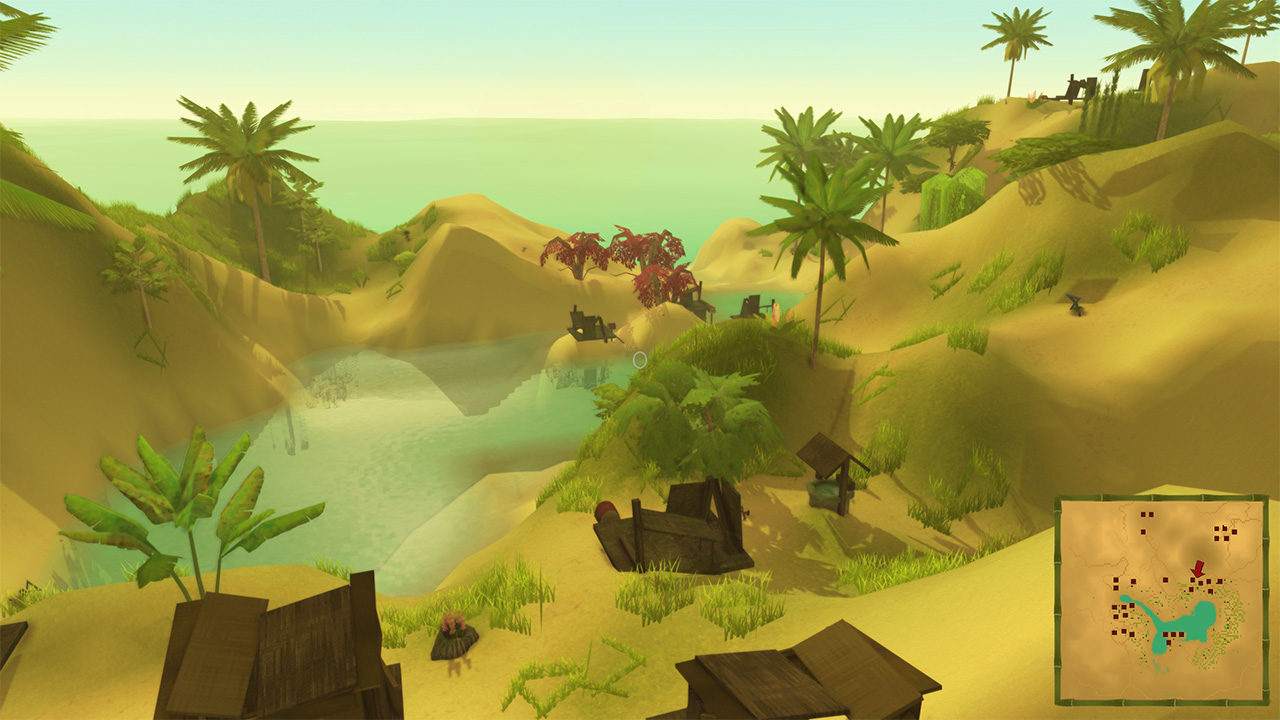
The Ebb and Flow and Life
There are several ways to try to play Tidal Tribe, but the overarching goal remains the same. As a humble character with god-like powers, you have the ability to raise and lower land. This causes nearby water to flow wherever you make canals, which in turn cause various forms of plant life to grow, which in turn local villagers can craft into items, with which they can then use to grow their civilizations. It’s an elaborate chain of events that all starts with digging in the dirt. All of the statistics needed to set this chain into motion are available to you (how much water, sunlight and altitude various plant species need), but as far as interacting with the world, the one and only thing you do is dig. If you’re close to the shore you can usually dig deep enough to produce a lake or two to help feed your thirsty world, but the main way is to channel the tides coming in from the ocean.
At regular intervals, tidal waves swell up along the coastline, and you can harness this to feed into your freshly dug tributaries. As a result, though, you’ll also have to continually defend your villages from flooding by raising land and building barriers. You can also freely walk around the ungainly landscape you have sculpted, at ground-level, and even help villagers to personally collect ripe fruit from the trees sprouted from your handiwork, or instead float off and admire the scenery from a birds eye view via a loftier, if flawed, higher perspective.
To Shovel or Not to Shovel, That Is the Question
Sculpting land is why this game exists, so it’s disappointing that the act itself is not satisfying, either on a technical or creative level. The sculpting mechanic is slow, imprecise, clunky, and limiting. Part of the disappointment is the extremely low resolution of the ground mesh. I’m not sure if this is for performance reasons, but the landscape is a surprisingly low poly object, meaning that any attempts you make at sculpting will end up looking like a lumpy blob. You can’t carve precise canals, lakes, or caverns, as there just isn’t enough detail to capture your creative attempts.
The sculpting brushes have no pressure setting either, so you can’t forcefully carve out a huge valley, quickly build up a tall mountain, or subtly smooth out an area with a light touch. Instead, the land under your brush erodes or grows at the same, glacial pace. Trying to dig a particularly deep hole, or high ridge requires an excess of patience. There are several brushes to choose from, but the biggest brush is never big enough, and the smallest brush is useless owing to the limited ground resolution. The culmination of this is that you’ll be brushing over the same area again and again and again as you try to sculpt the land to your water-logged whim. And the brush choices themselves are mostly size variations, rather than serving different functions; there is a smooth brush, but oddly there’s no “flatten” brush, or any other way to make level terrain, and although there is a square brush, the results look no different than its round cousins because there just isn’t enough resolution to show off anything other than blobby mounds.
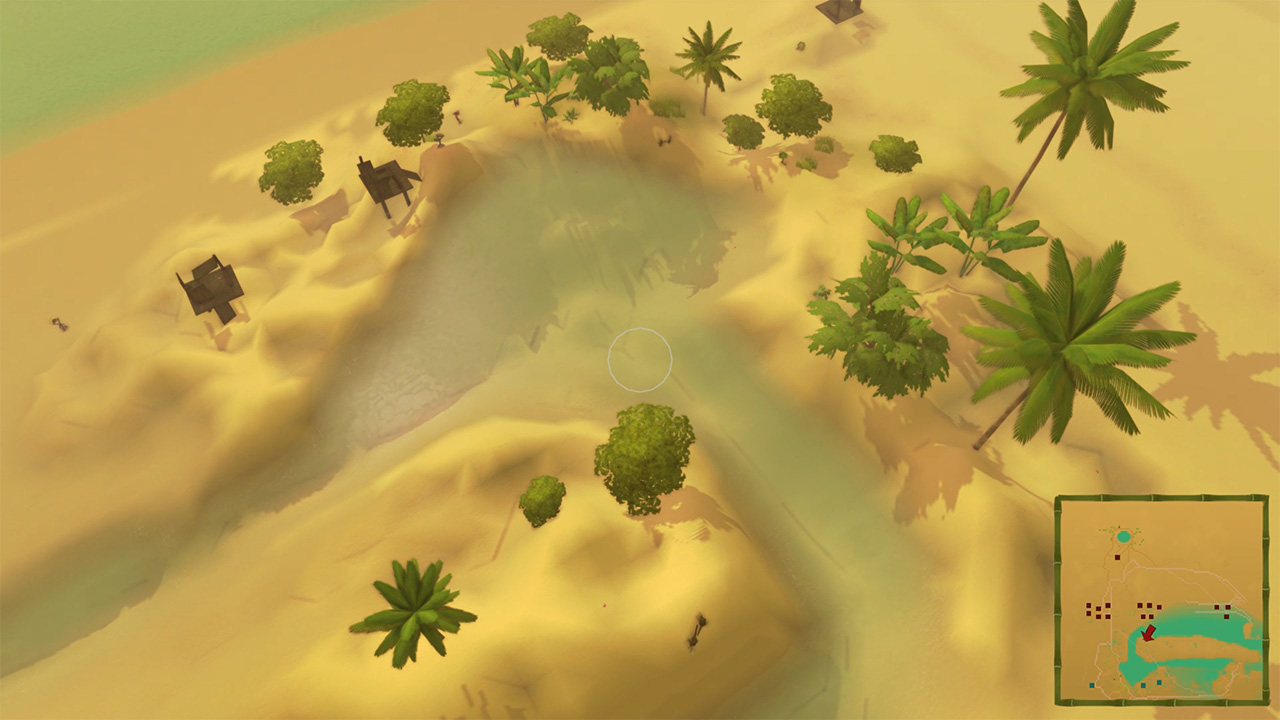
The water level does not have a high enough visual contrast to stand out from the rest of the landscape, so often times it’s difficult to tell how you’re progressing with your waterworks unless you zoom in fairly close, but the closer you get the uglier the ground looks. As you sculpt, garish dark lines start appearing where the texture map isn’t fitting the new landscape, so the earth beneath your cursor starts to look more and more abstract as you continue working with it. There are no graphical cues to indicate how far you’ve dug either, no visual strata of sand, rock, and other sediment, it’s just the same light brown color, so it’s not immediately obvious how much or little you’ve changed the landscape. Of course, none of this is helped by lackluster camera controls, so even if you could sculpt the landscape of your dreams, you’ll spend more time fighting the process than reveling in your very own Garden of Eden.
A Stick in the Mud
But even if you are able to put up with the mediocre landscaping tools, it’s an even bigger compromise when it comes to the controls. The movement, control scheme, and overall navigation are a jumbled mess, making the actual playing of the game quite a chore. It’s apt that Tidal Tribe is all about water, sand and mud, because that’s what it feels like you’re trudging through while playing it.
Physically moving around the game world is unbearably slow. Movement itself is broken into two modes, you can walk around on the ground alongside the villagers, or you can hover above the world and fly around the map to sculpt. Walking around is the default, and though slow, at least you do have the ability to sprint; but being earthbound in a god-game is more a hindrance than a benefit. The majority of the time you’ll be surveying land, so it makes sense to remain aloft. When hovering, though, the speed is even slower than walking, with no ability to sprint, leaving you forced to drift lazily from one spot on the map to another. Seriously, a painted cloud moves faster than you do.
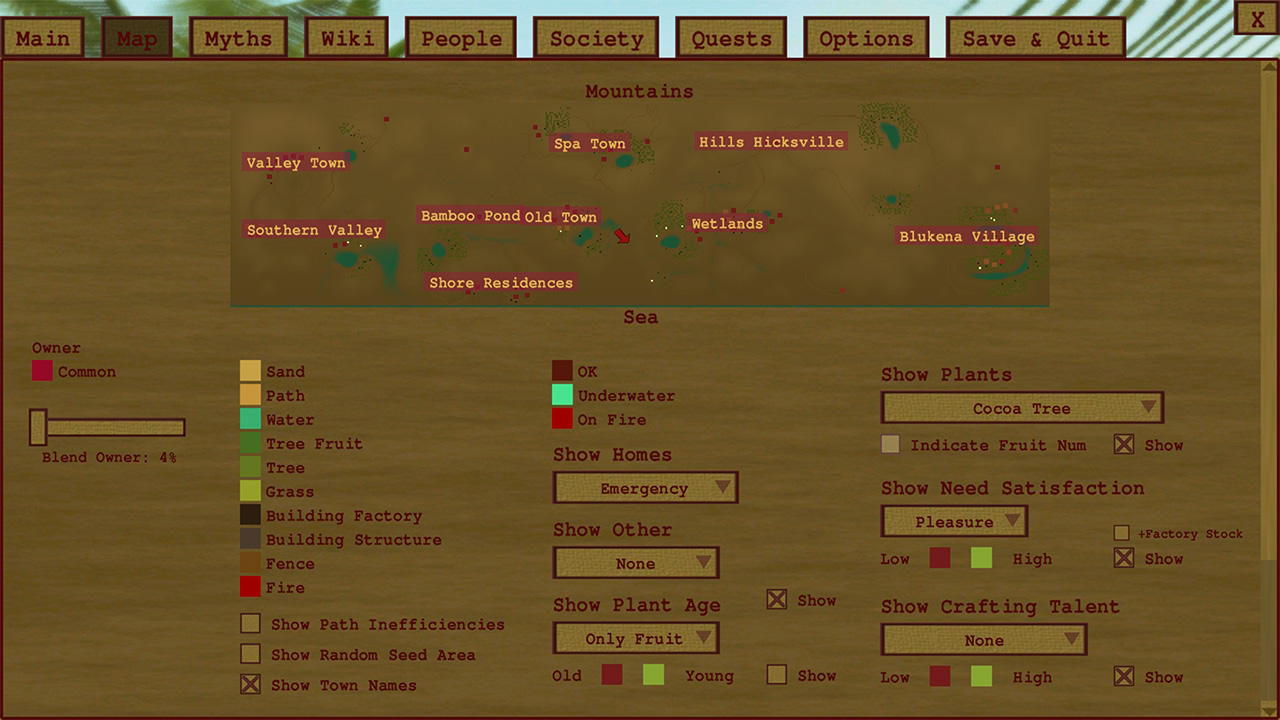
But even then, that’s still too slow. The entire concept of movement in this game is a mismatch, perhaps. The approach is more of a FPS scheme, with WASD controlling movement and the mouse controlling the view. But Tidal Tribe is best when it’s a god-game, not first-person, and most god games tend to have more of an RTS scheme, an isometric view favoring fast navigation over large maps. This is also evident when using the built-in map in Tidal Tribe. There are global events that happen across a large landscape with many villages, resources and activities that need your attention; and though these items are displayed on the large map, there’s no way to fast travel to anything. You may have god-like powers, but you’re still stuck walking or slowly floating everywhere.
A Speck of Sand in Your Eye
Tidal Tribe is asking its players to be forgiving visually as well, since the overall graphics are not as good as they could be. And it’s not the art style that’s the issue, it really comes down to basic design and clarity. The color scheme in this game is depressing. Everything is drab, which seems at odds with the theme of using water to grow life. The blues are brownish-blues, the greens are brownish-greens, the purples are brownish-purples. And it’s not just about making things more colorful, it’s about bringing contrast to the game. Right now, landscaping, people, object, and sculpting are all part of one indiscernible visual mud-pile.
To get the most out of the game, you’ll also need to spend time in its menus. The tabbed pages give you stats on plants and growing conditions, info on the people who inhabit each village, and a large statistical map. But the presentation of this information is as muddled as the landscape below. Fonts, colors, and layout all co-mingle in a garish soup that constitutes the game’s UI. Again it’s a readability issue, compounded by poor organization. The map screen, for example, gives you various statistical views, but the color contrast is not strong enough, and the map legend options are overwhelming, leaving the screen more confusing than informative. When using the “Growing Conditions Indicator” mode to find optimal growing conditions, choosing plants is cumbersome, and the heads up display is not always helpful. It’s too bad the landscape itself can’t be color coded with heat-maps showing these things, that way you could see firsthand the effects as you sculpt.
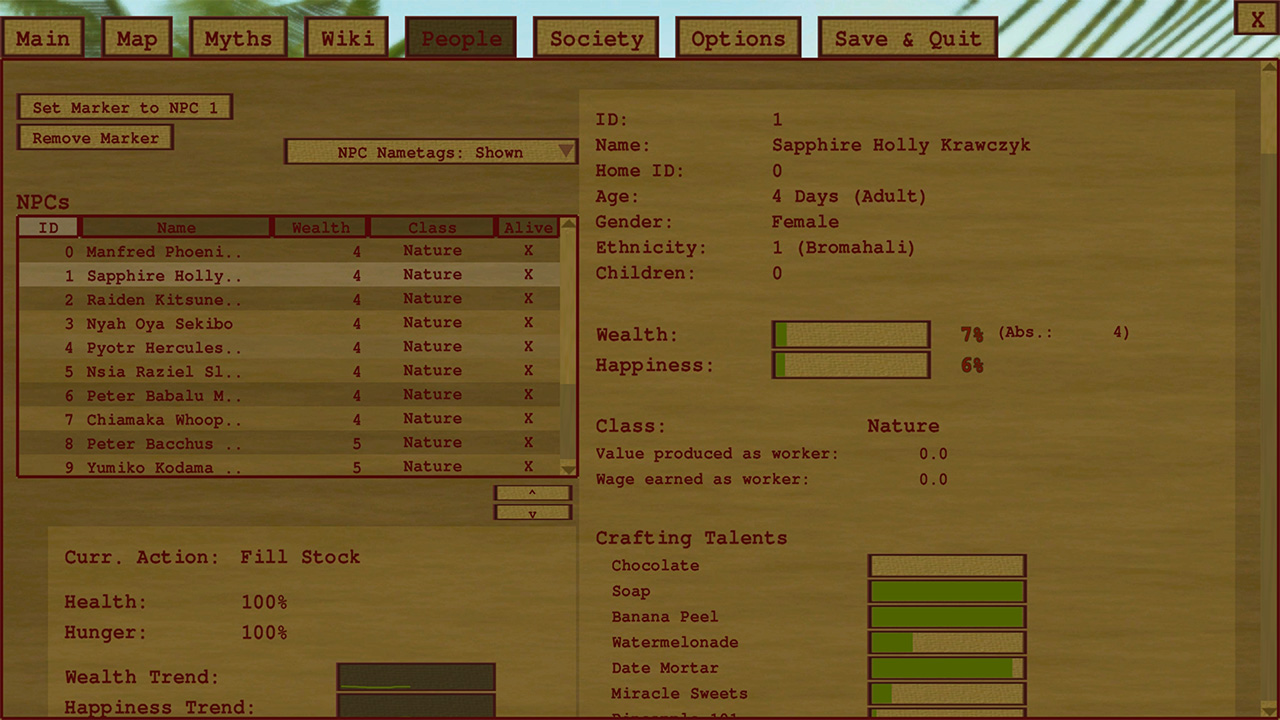
Despite the tides ebbing and flowing, despite plants growing and dying, and despite villages rising and collapsing, the sun never really sets in Tidal Tribe. There’s no day/night cycle, there’s no sense of time passing, or that the world you’re inhabiting is even alive. True, there’s a preference when you start a new game to choose the time of day, but that’s only if you start a game from scratch, and once in play, time never seems to change.
Sonically, though, the game succeeds where it fails visually. The music is well done, varied, and matches the mood of the game perfectly. The sound effects and general ambience add a much needed burst of life to the otherwise plastic-looking map. The combined effect produces a relaxing and inviting atmosphere, one that beautifully accompanies hours of play, should you be able to tolerate the game for that long.
When the Tides Turn
Playing in a large digital sandbox can be fun, even if the tools can’t hope to match your ambitions, but even then things get repetitive without strong goals or an overarching direction. Tidal Tribe is too sandboxy for its own good. Unless you’re personally a very self-directed player, there’s not a lot in the game itself to urge you forward or to measure progress against. The “big picture” goals feel optional, and the consequences feel non-existent. Yes, there are mini-goals, such as having to grow a certain number of plants, or helping a village to advance to a certain level, and there are even fun little bits thrown in like treasure maps. Yet, somehow, these elements don’t add up, they don’t feel like they belong together or offer meaning to the game as a whole, it’s just busy work.
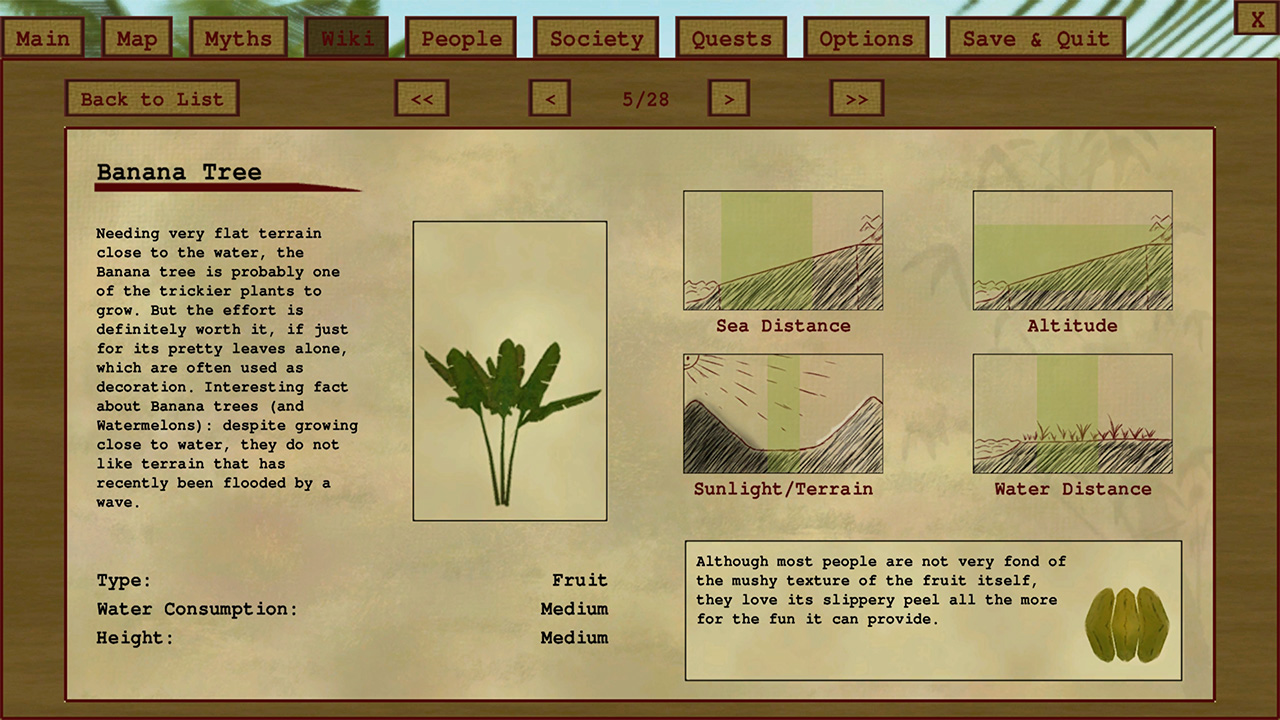
Tidal Tribe has no gameplay flow (pun semi-intended). The system is so non-linear that it’s a sand-and-surf free-for-all. There are rival tribes, but they’re fairly inert, and as already mentioned, the lack of a distinct timeline means there’s no sense of progress or other way to measure your success. This makes it difficult to judge how long things take to grow, what the lifespan of the villagers is, or what time limits you must work within to achieve your goals. The game does offer a few options to up the ante, if you’re looking for a challenge: several modes give you crisis scenarios to play through, which do have specific conditions, but these wind up being more stressful than challenging, mostly owing to the lousy sculpting and view controls.
Dig, and You Shall Find
So far in this review I’ve had very few positive things to say about Tidal Tribe, and by all rights my review score should be much lower than what it currently is. Am I “grading on a curve” simply because the entire game (coding, graphics and music) is the work of a single person? Perhaps; allowances should be added when a developer is pulling triple-duty like that. But beyond that, I admit to having a soft spot for the game, because despite the disastrous execution, the core idea is good; great even. There is so much potential hidden under the surface, and the developer has been quick to provide updates and improvements, so there’s every reason to be hopeful that Tidal Tribe has a bigger future ahead of it than where it currently stands.
The underlying mechanics are really fascinating; I love the concept of a god-game that focuses on water and growth to indirectly help its villagers, rather than the overt methods of directly intervening with a civilization. If you have a head for statistics, peeling back the topsoil reveals a lot of intriguing variables that are being factored in behind the scenes, such as pollution, shelter, and even happiness of the villagers. So, even though the only thing you can do is sculpt land, there actually is a lot more going on that keeps the world afloat. Plus, it’s refreshing to have a game that isn’t obsessed with armies, conquests, and conflicts. When the systems are working at their best, the game can indeed be quite relaxing.
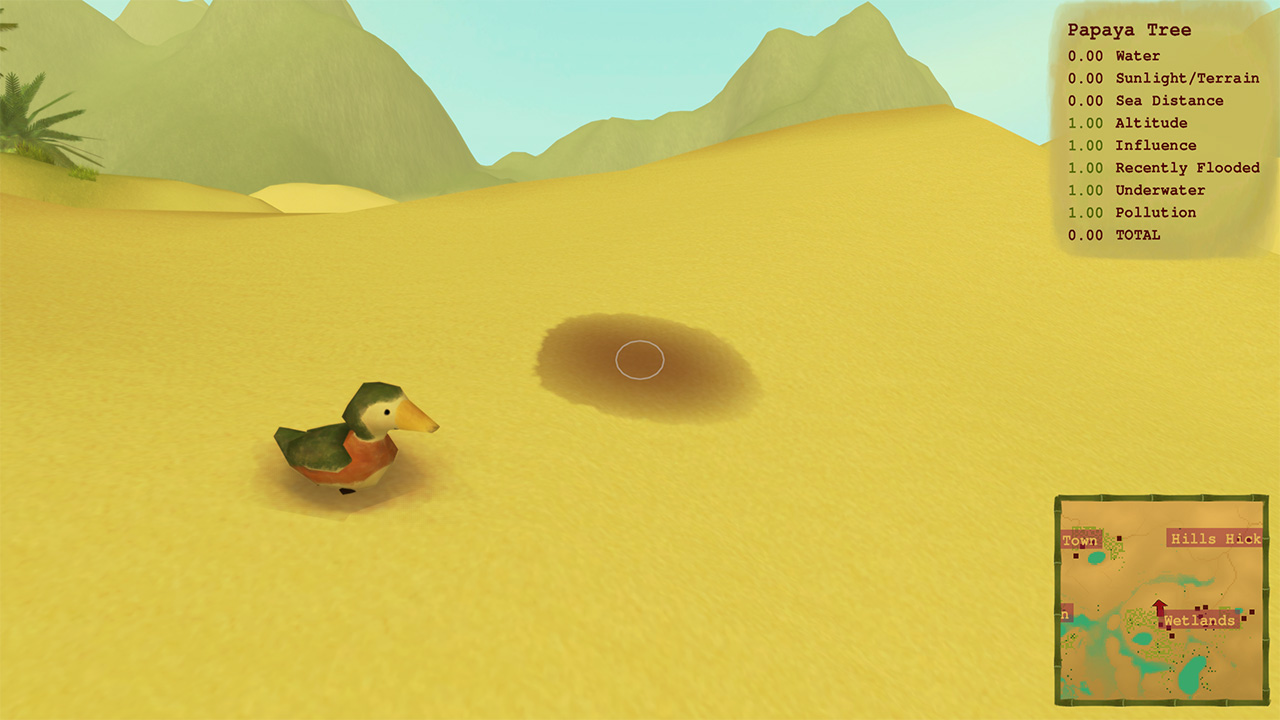
Verdict
Still, It’s difficult to recommend Tidal Tribe in its present state. On one hand I simply cannot recommend buying it, because of the unsatisfying sculpting, awkward controls, muddy graphics, and general lack of direction. But on the other hand, I firmly believe that there is enough momentum in this game that with continued development it could achieve the features it promises. Tidal Tribe possess a raft of clever and innovative ideas, but at the moment, most of its potential still lies buried under a misshapen layer of silt.

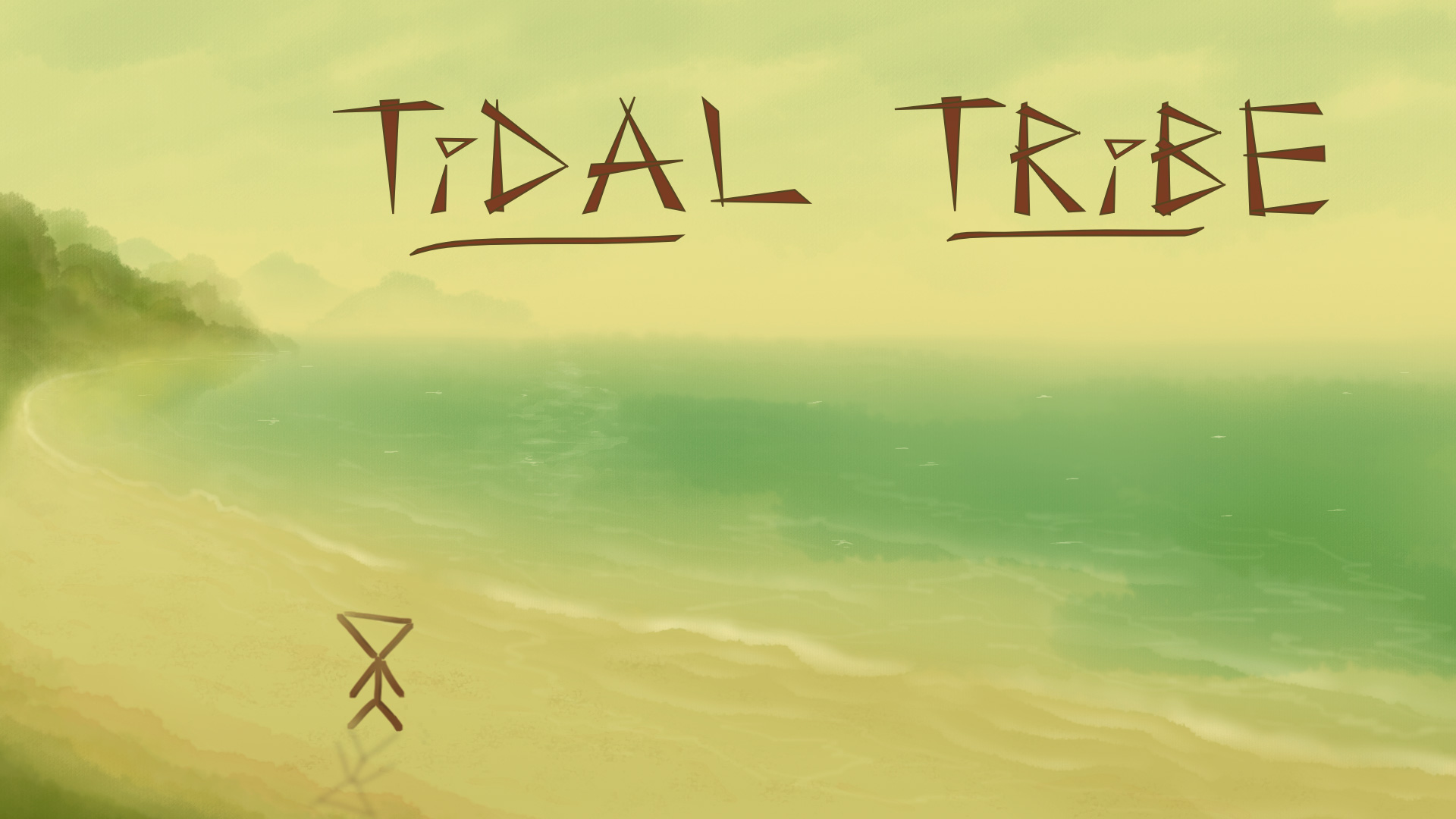









First, thanks for the review! 🙂
And just to address some points:
– Hovering is only meant for building, that’s why it’s slow^^ If you want to move around fast, you can glide 🙂 (I don’t know when you’ve played the tutorial, but I’ve recently made that clearer, since a lot of people missed that)
– Sorry, I just love earth tones too much, that’s why everything is in a brownish color scheme :”D But I get that it probably doesn’t appeal to everybody^^
– I feel like maybe you focused too much on digging down to build lakes? Because so far most people seem to quite enjoy the building. Generally it’s easier (and faster) to build walls to capture water that’s flowing down from the top, instead of digging down (which can indeed feel tedious). Here’s a video that shows how you can for example cover the first level in plants in just about 10 minutes: https://www.youtube.com/watch?v=SsSrEbjpTrk
– The reason I didn’t add a super strong brush is simply that it would make it too easy to quickly reshape everything. I wanted the player to find ways to use the terrain available to them, instead of simply removing every mountain they don’t like^^
– As you assumed correctly, yeah, the resolution of the ground mesh is unfortunately limited by the performance that the fluid simulation requires. As for the dark lines: that’s unfortunately an SSAO artifact. If they bother you too much, you can disable the SSAO.
– As far as goals are concerned: the main missions are always just focused about upgrading the homes, but there are also a bunch of side missions that have different goals (e.g. protecting a world with high erosion from floods, fighting wildfires, fighting a parasite infestation, etc)
– Day-night cycles should hopefully be added in the near future 🙂
Thanks for taking the time to reply! You bring up some good points, and although I didn’t get into them in the review itself, they were things I was mostly aware of, and had already accounted for.
For example, the glide mechanic felt very awkward to use, and didn’t make movement any faster, so I wound up not using it during my playthrough. This also goes back to my opinion that the movement in a game like this doesn’t work as well with first-person style controls, and would be better suited for more of an overhead, RTS like scheme. This is, of course, just my own personal opinion, and is based partly on my assumptions of what a “god-game” should look like. To be fair, I appreciate that you’re trying something new and different.
As far as colors, there’s nothing wrong with earth tones, and they are well suited for the island theme, but the color palette is in desperate need of contrast. Complimentary colors, accents, something to bring more sharpness to the scenery and provide stronger juxtaposition, otherwise a lot of the game’s elements tend to blend in with each other, their values are so similar.
Sorry if it came across that I was overly focused on digging lakes, that was just an example because it represents the extreme end of the brush system. The point was that there’s no real difference between large, broad sculpts, and small, subtle ones; everything moves and reacts the same. Slow build-up makes sense some times, but not at other times, and that seemed to negatively affect the game’s pacing for me.
As far as the super strong brush, perhaps your decision is wisest, considering the goals of the game. Still, I really wanted to go crazy sculpting the landscape 😉
That’s very good to know about the SSAO being the culprit of the dark lines; that’s easy enough to disable and helps to clear up that issue. As for the ground mesh resolution, it’s probably not an easy thing to change, but it would be nice if the game supported higher resolutions, provided the player’s machine could handle it. Also, that’s very cool to hear that you might be adding day/night cycles in the future, that would really add some interesting possibilities to the gameplay!
Again, thanks for taking the time to post your comments! It looks like you’re continually upgrading the game, so I’ll be sure to check back periodically to see how it’s expanding, as I do believe you have a great idea here and a there’s a lot of potential still waiting to be discovered!